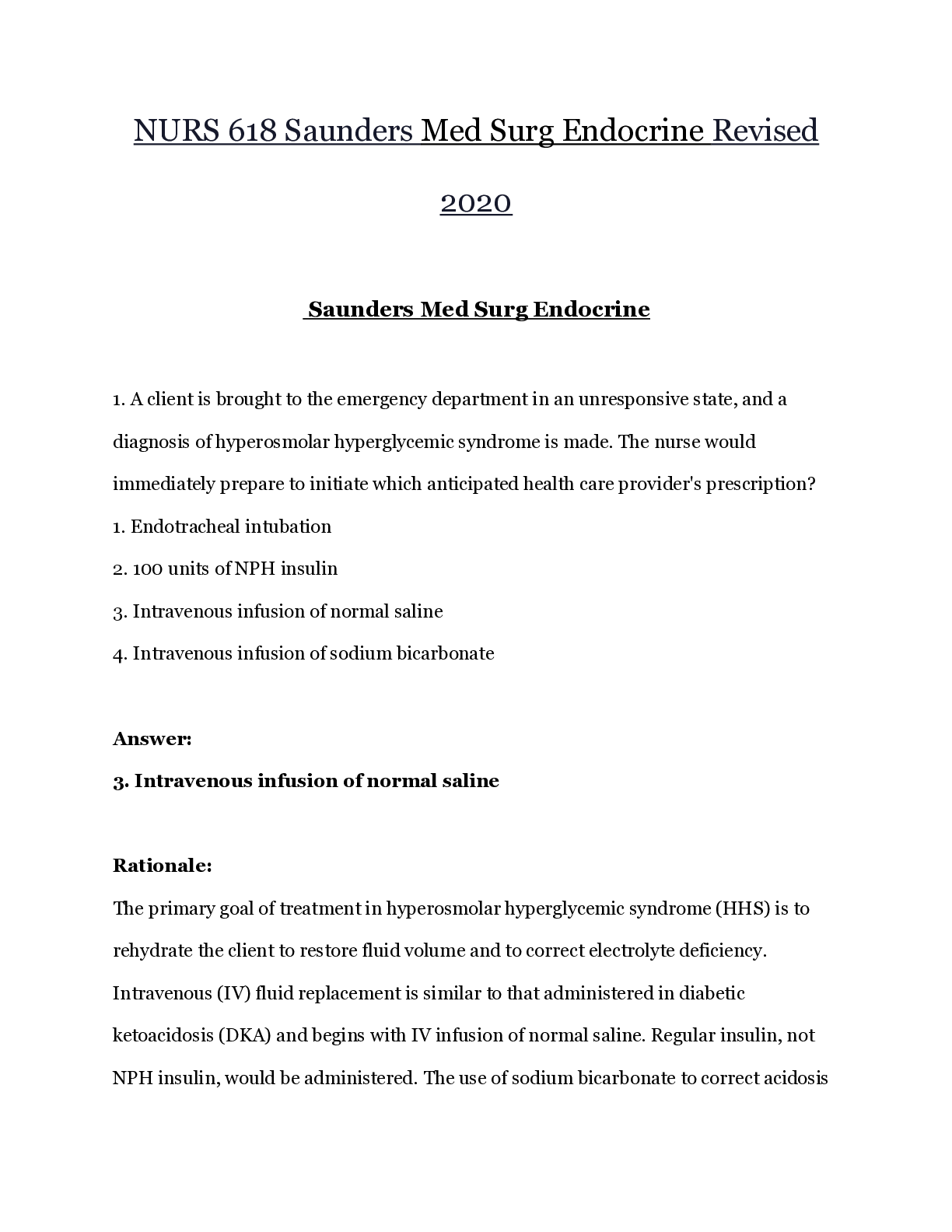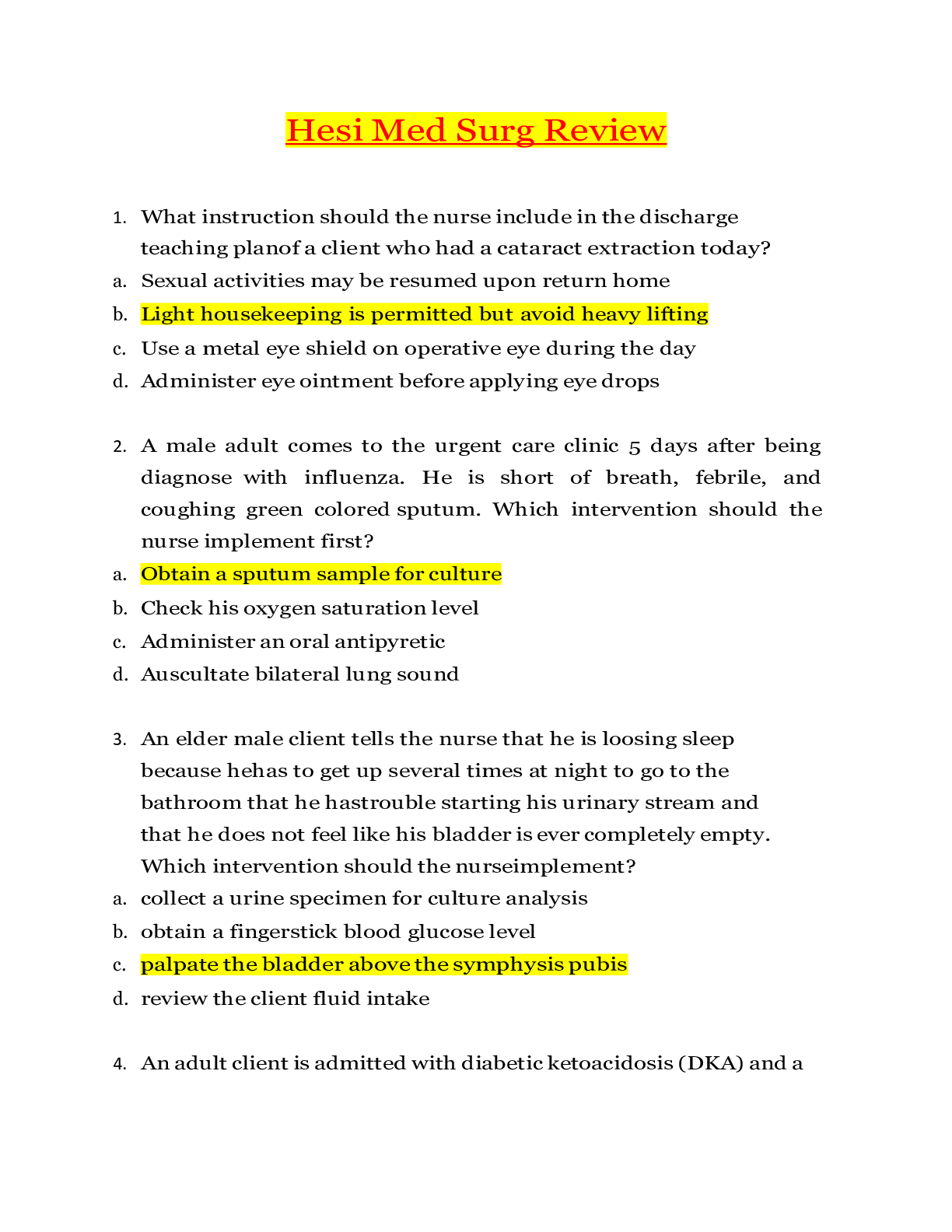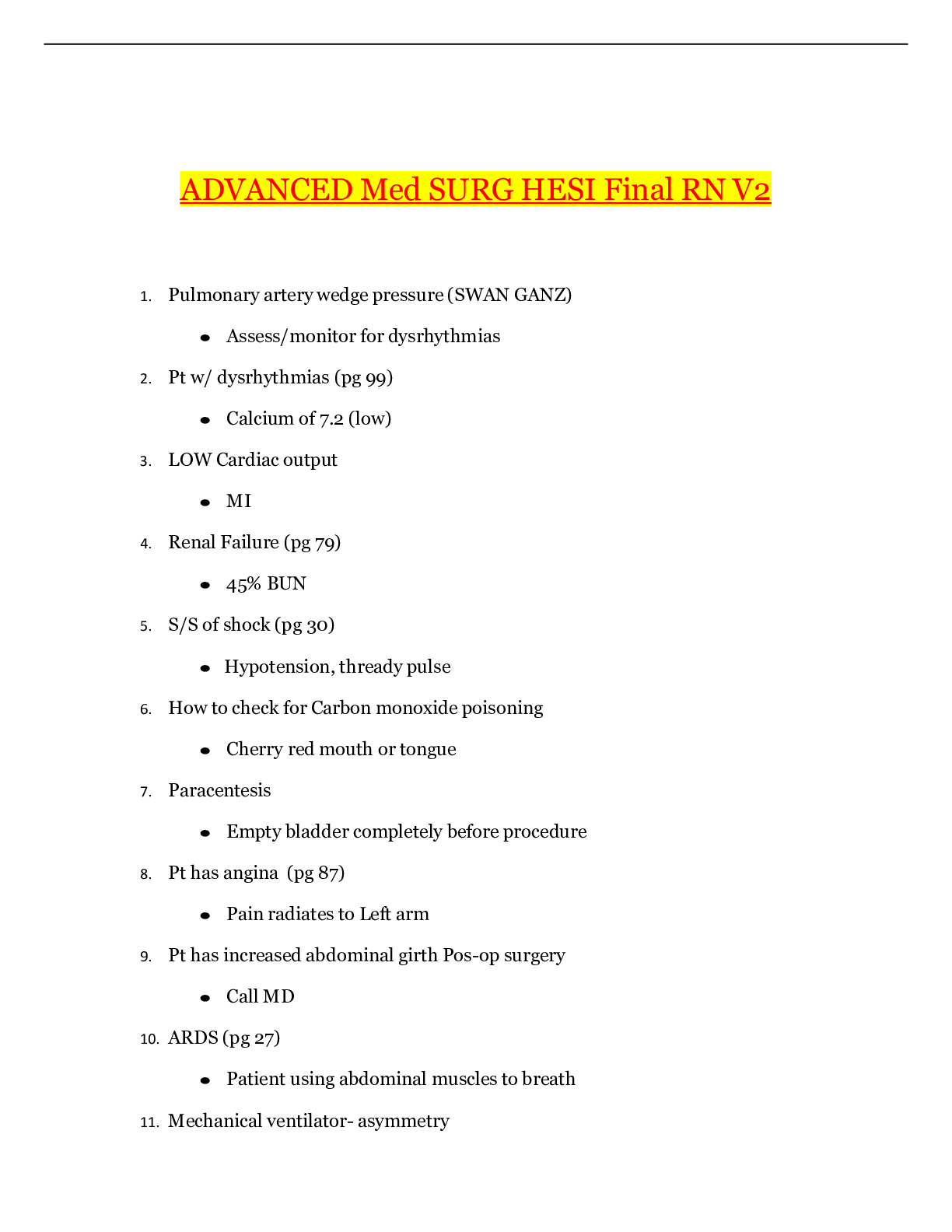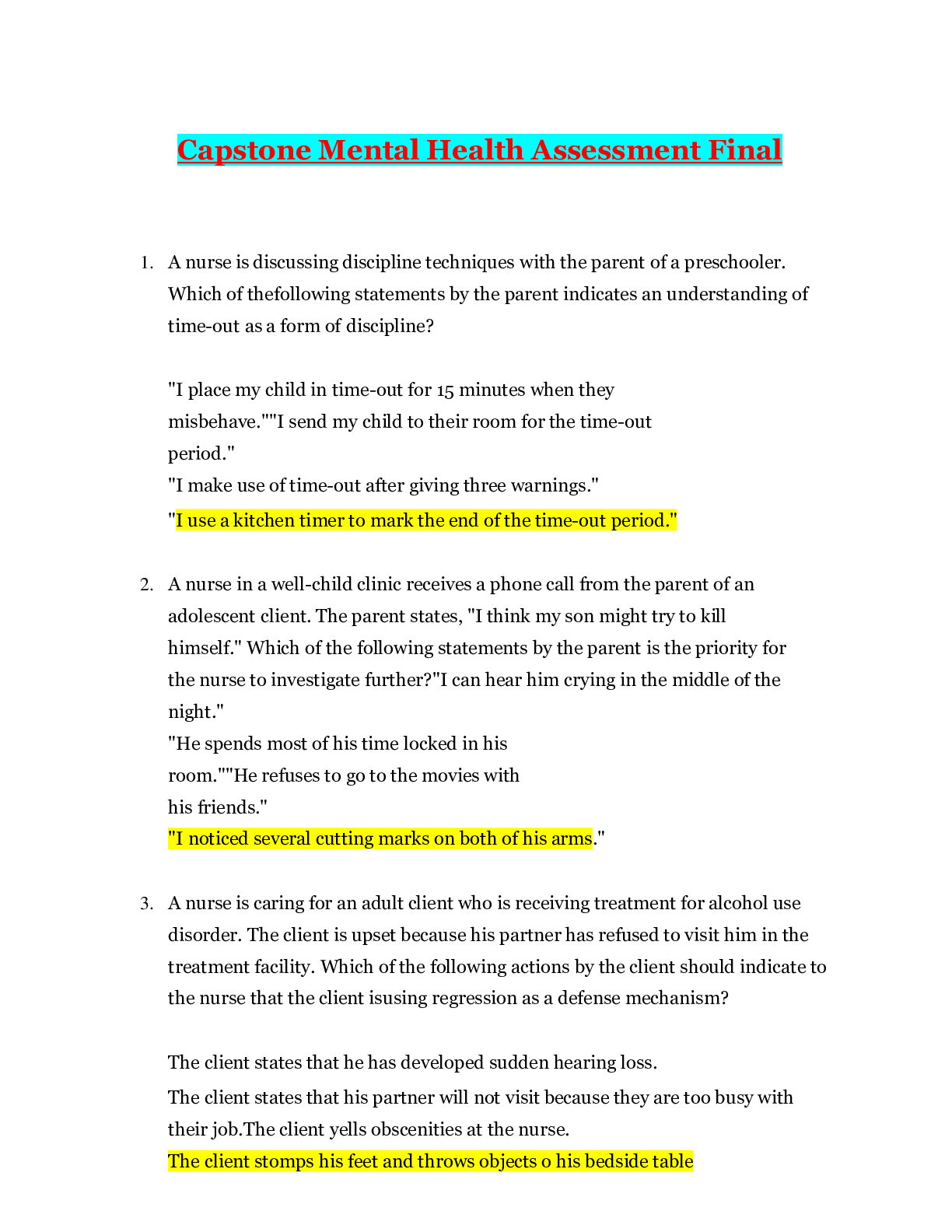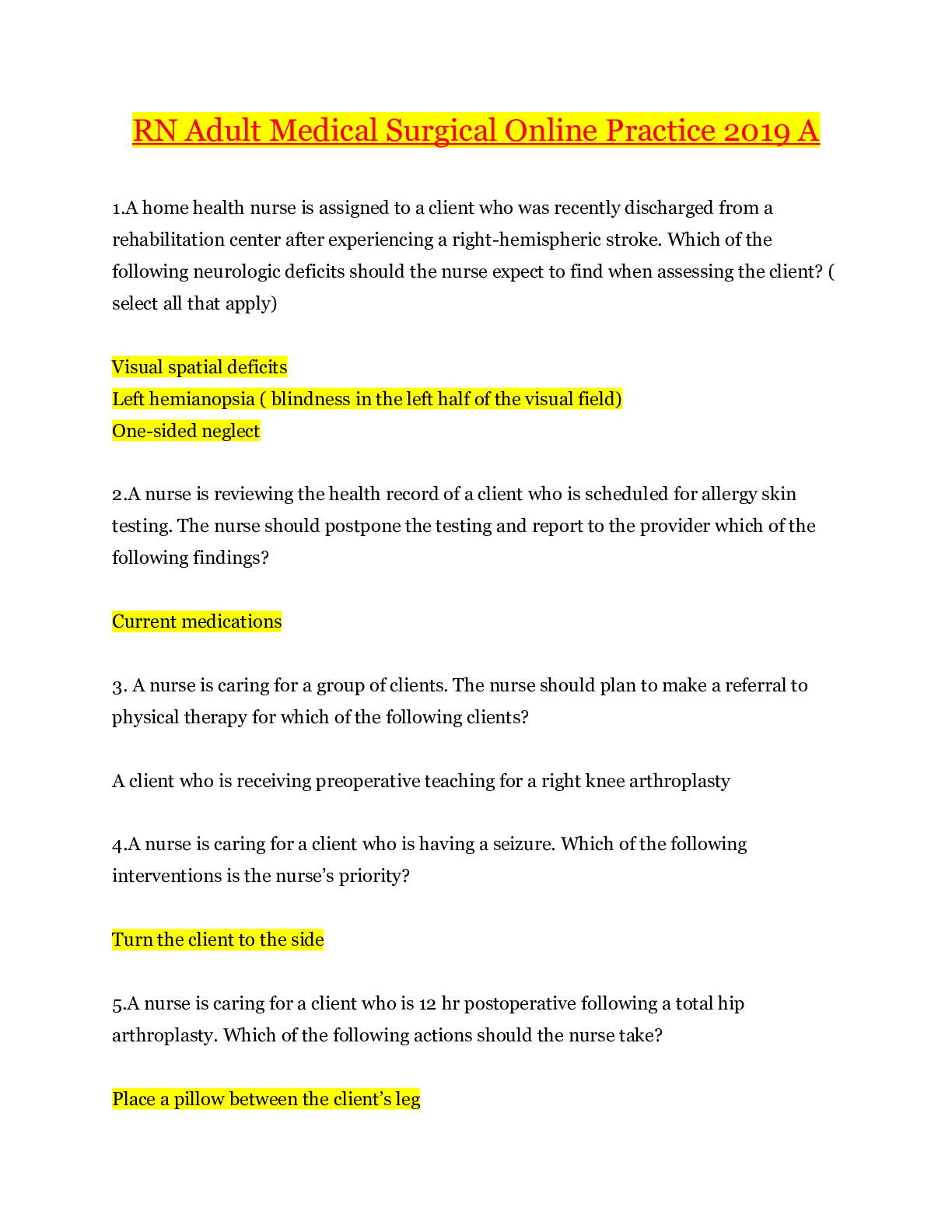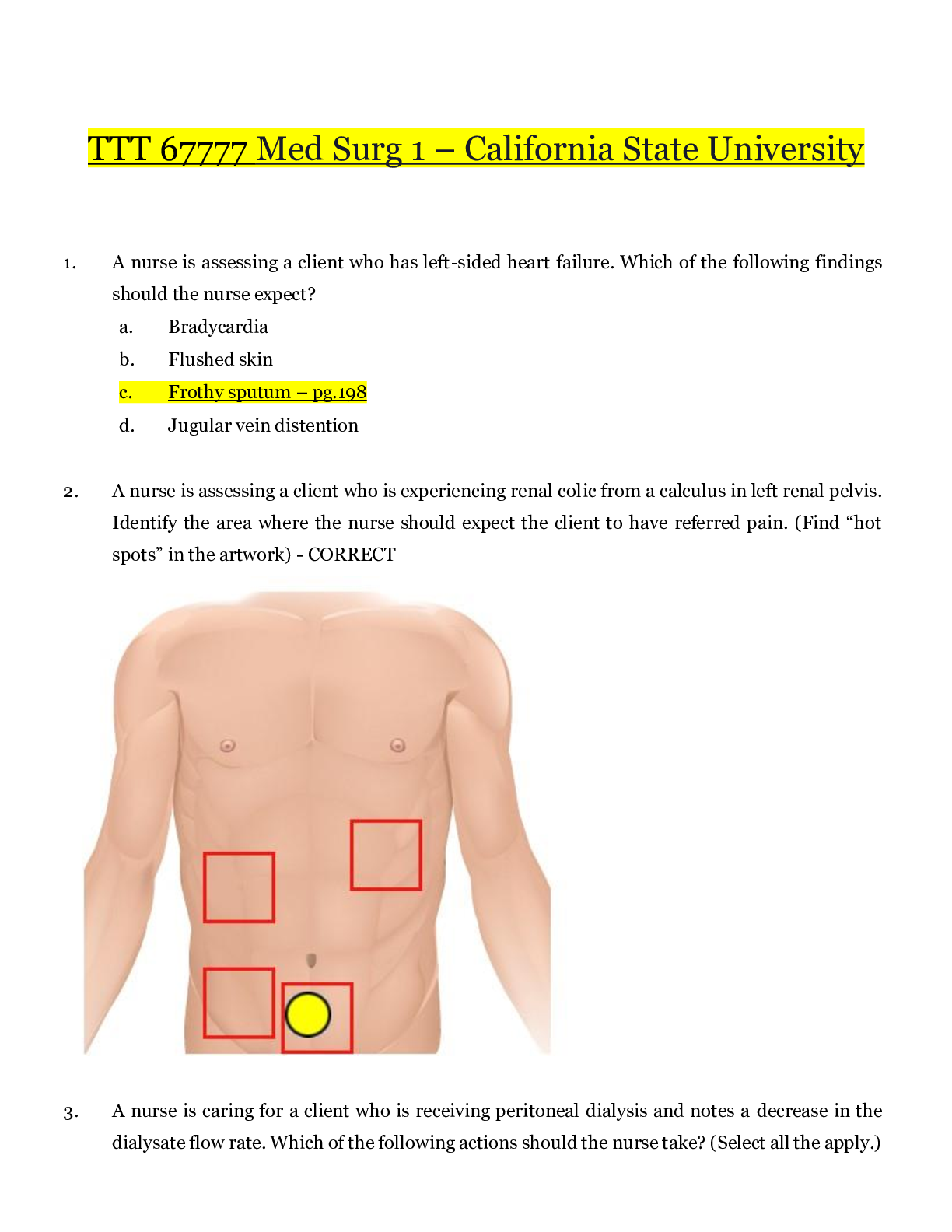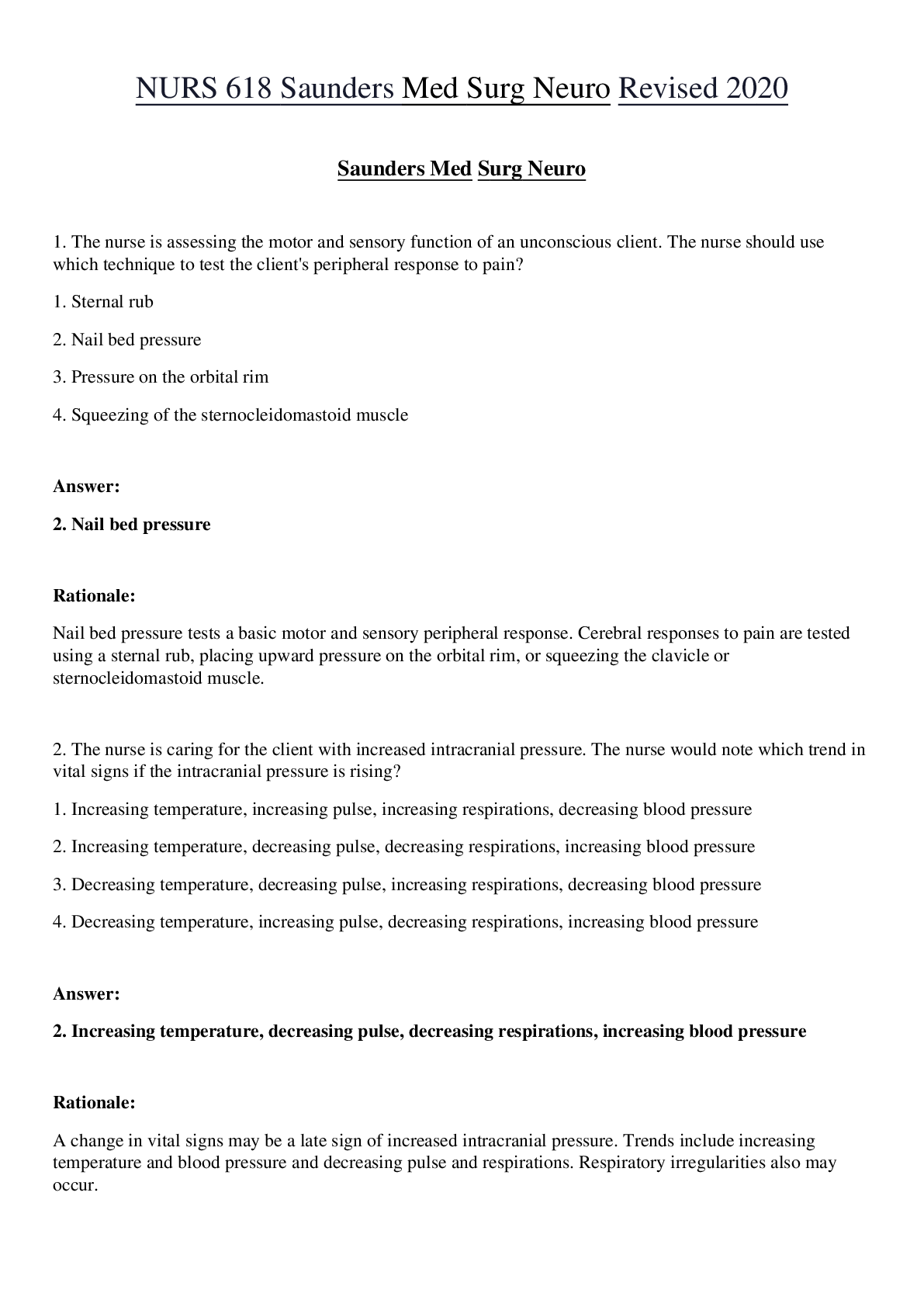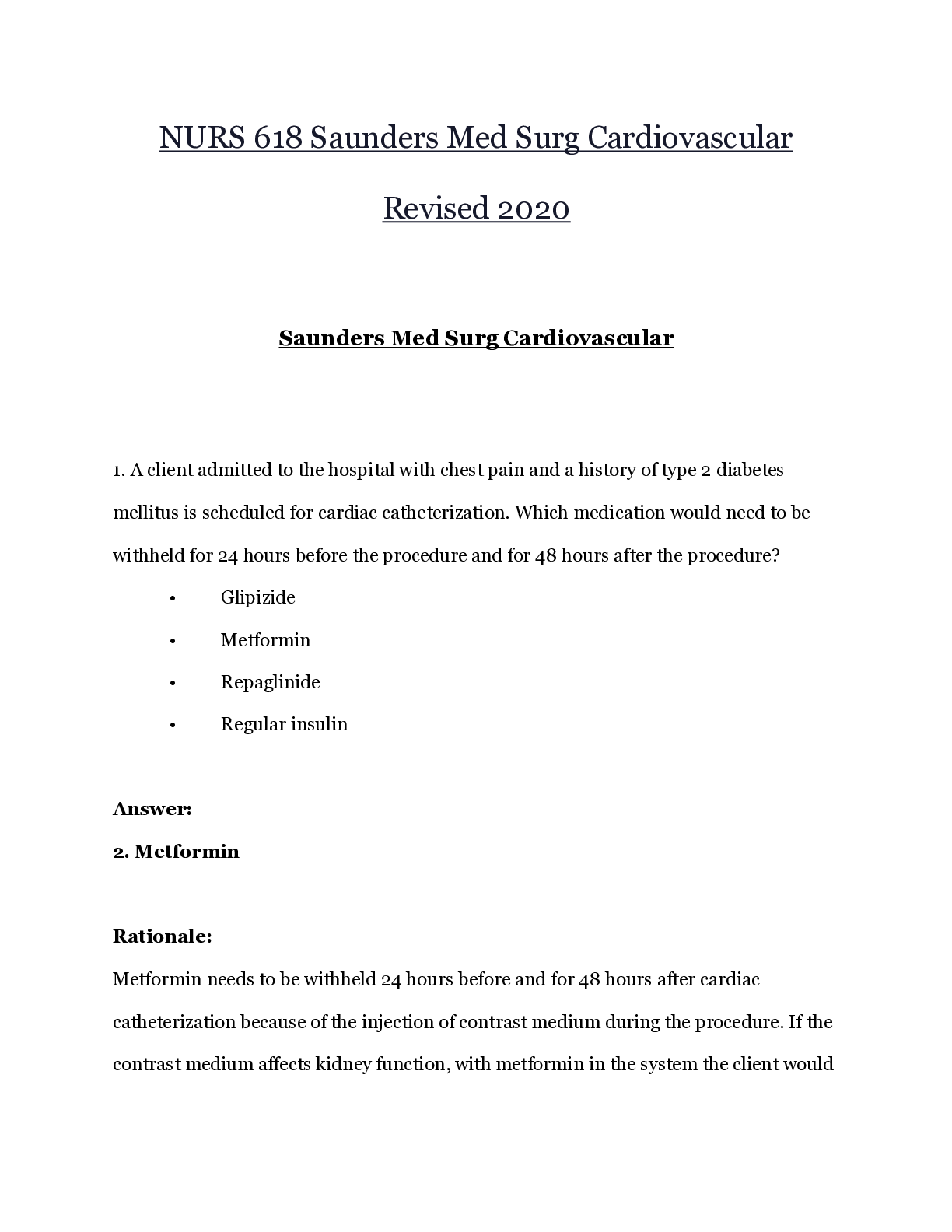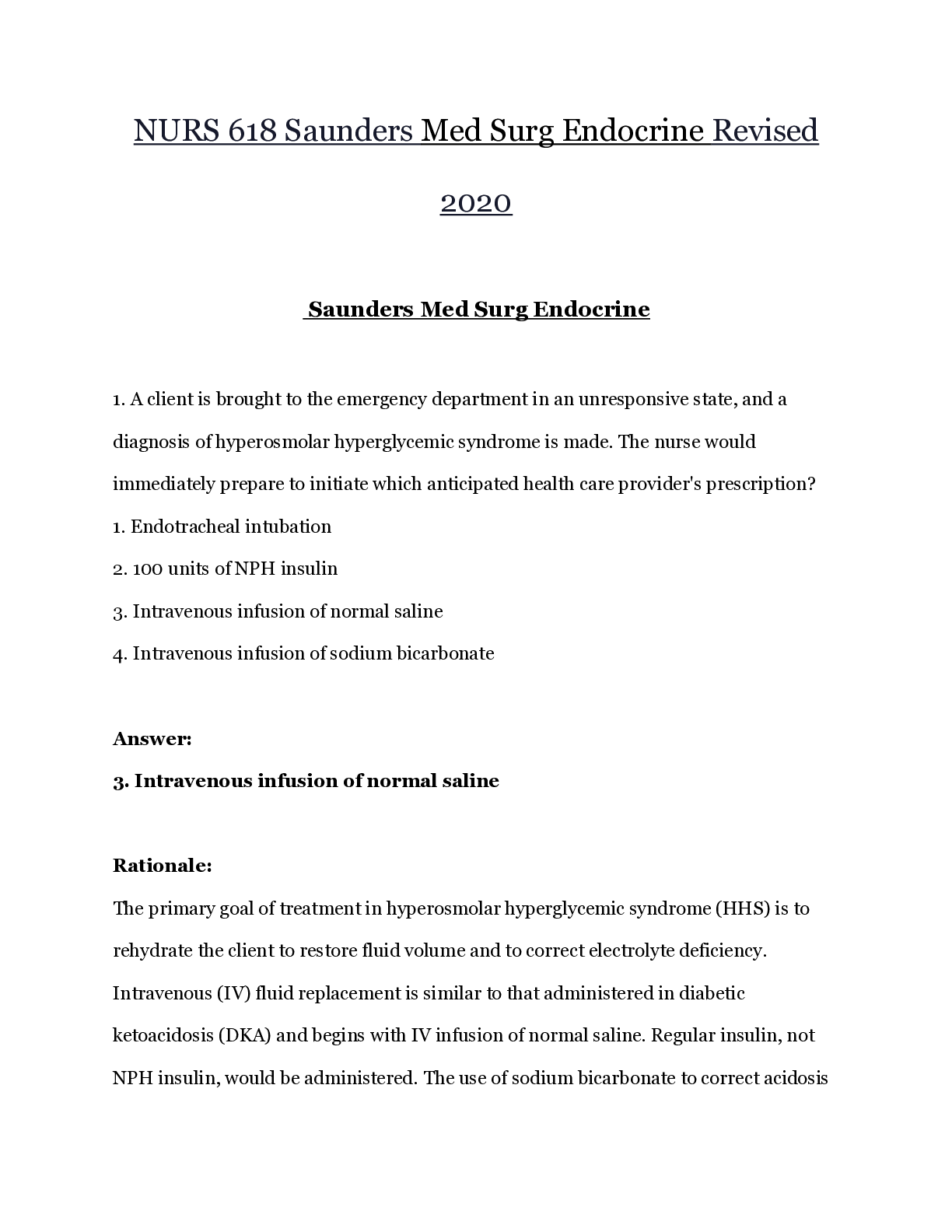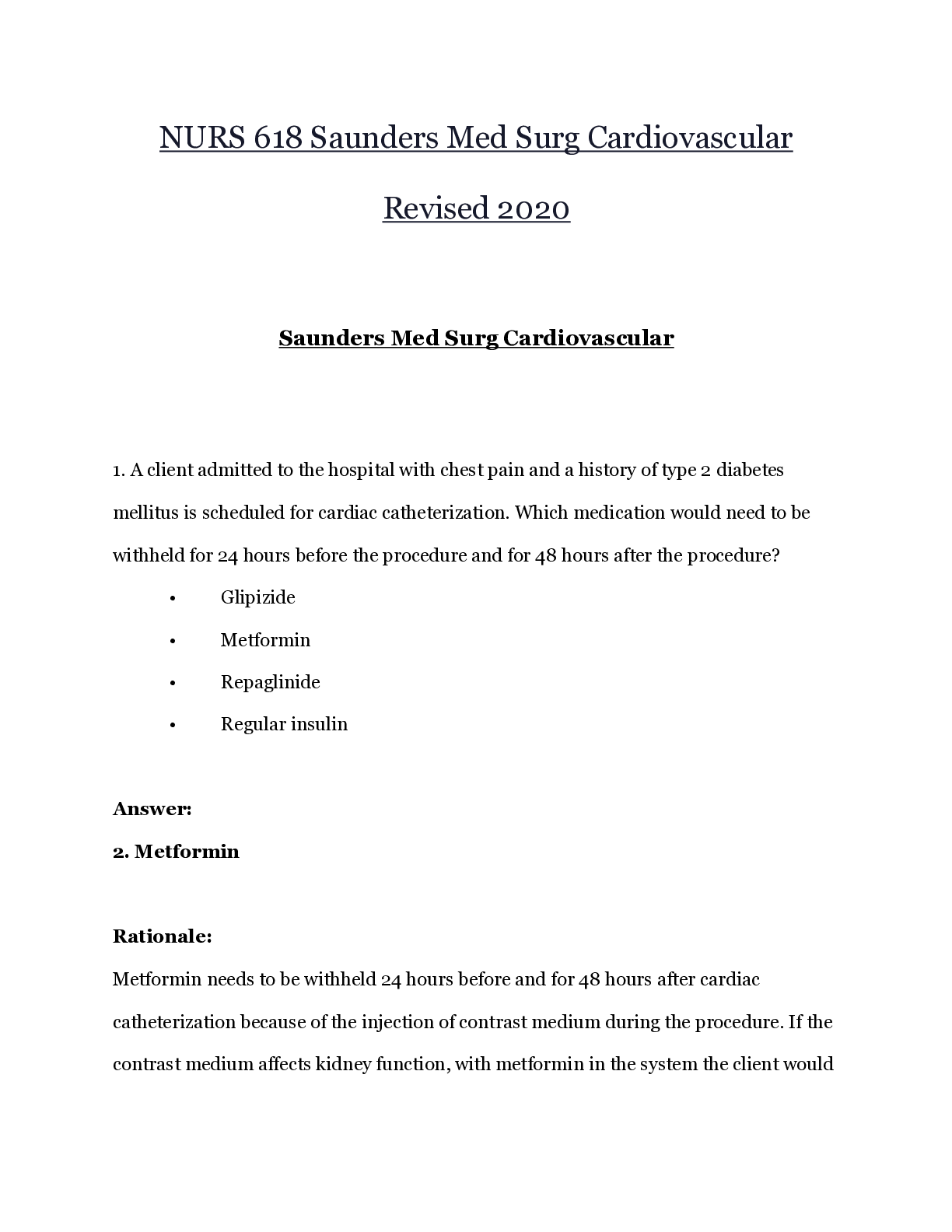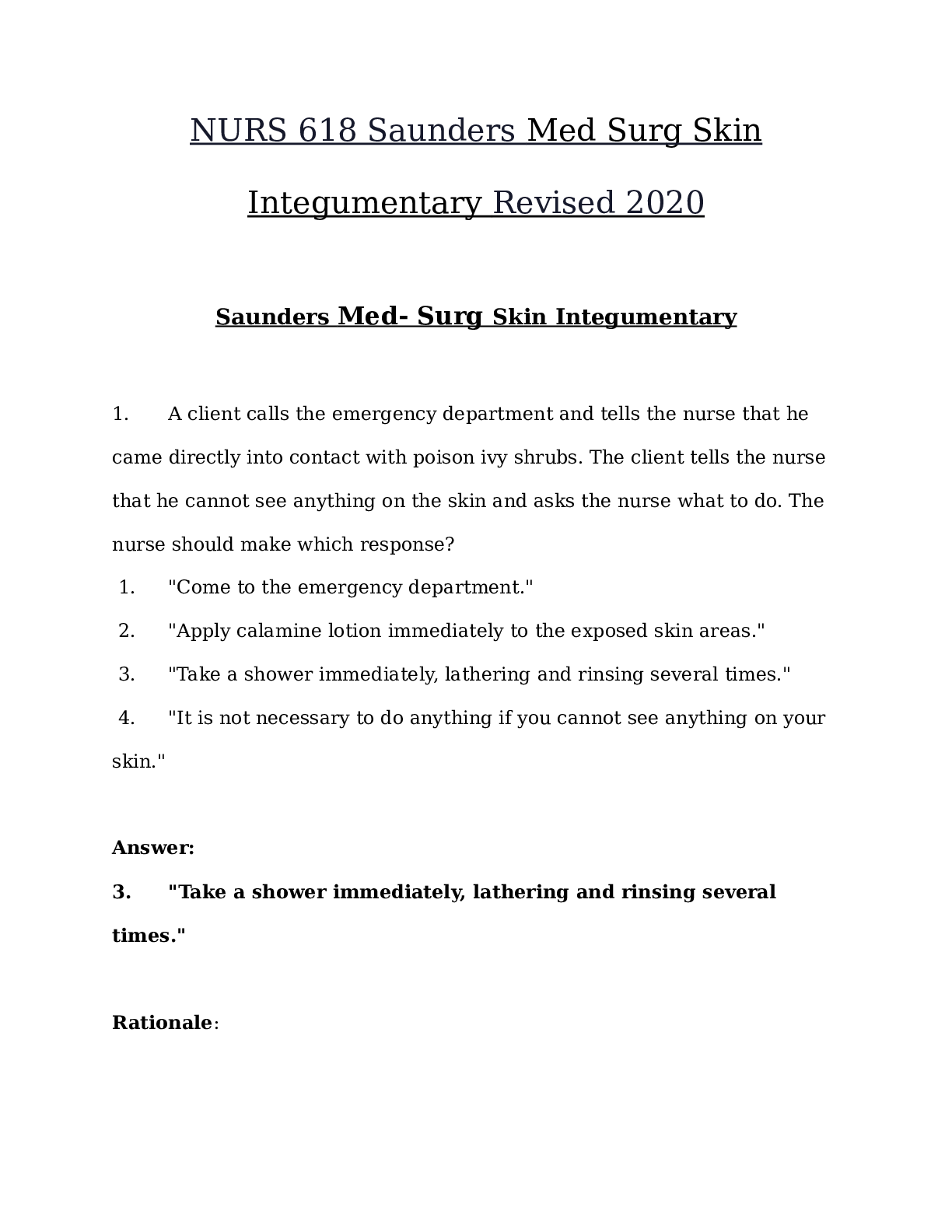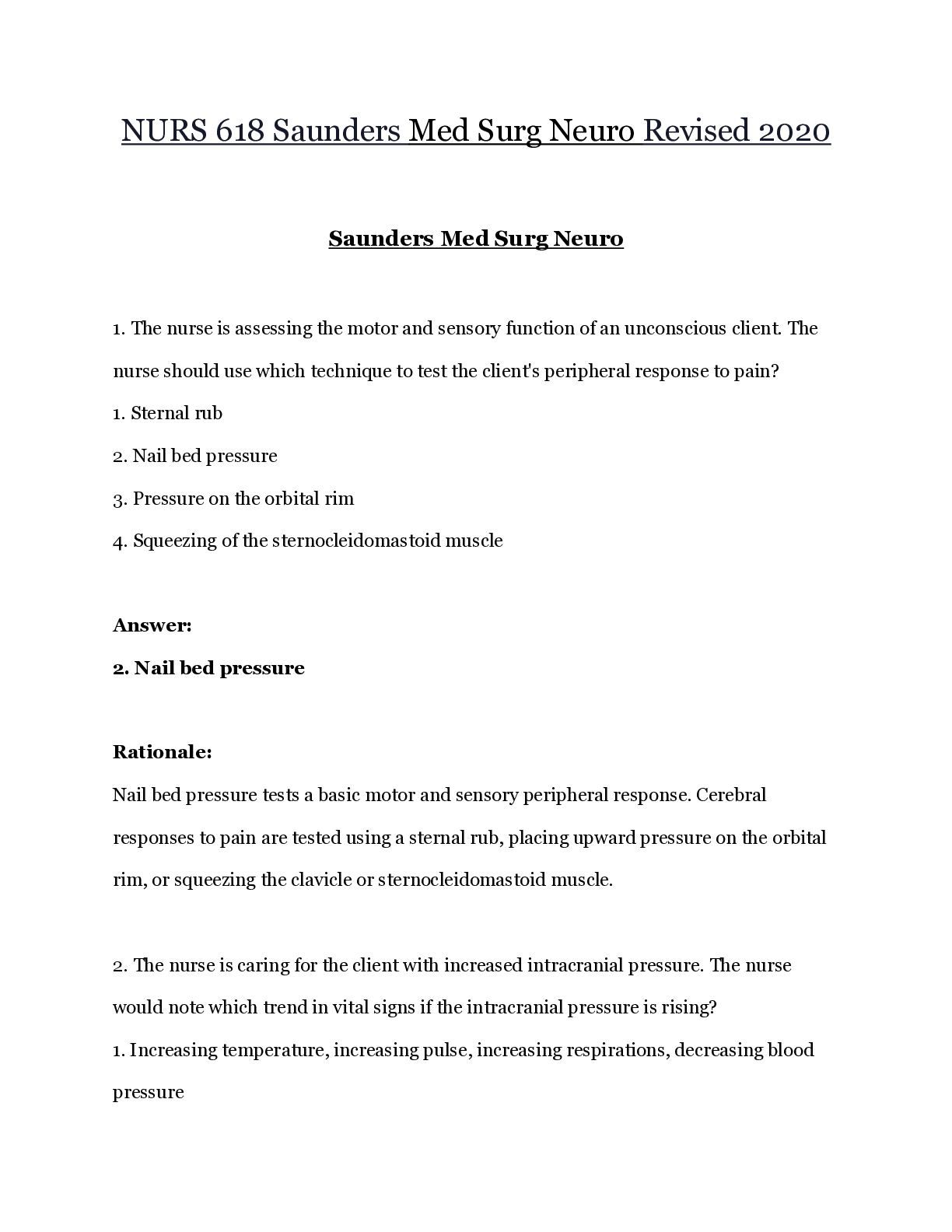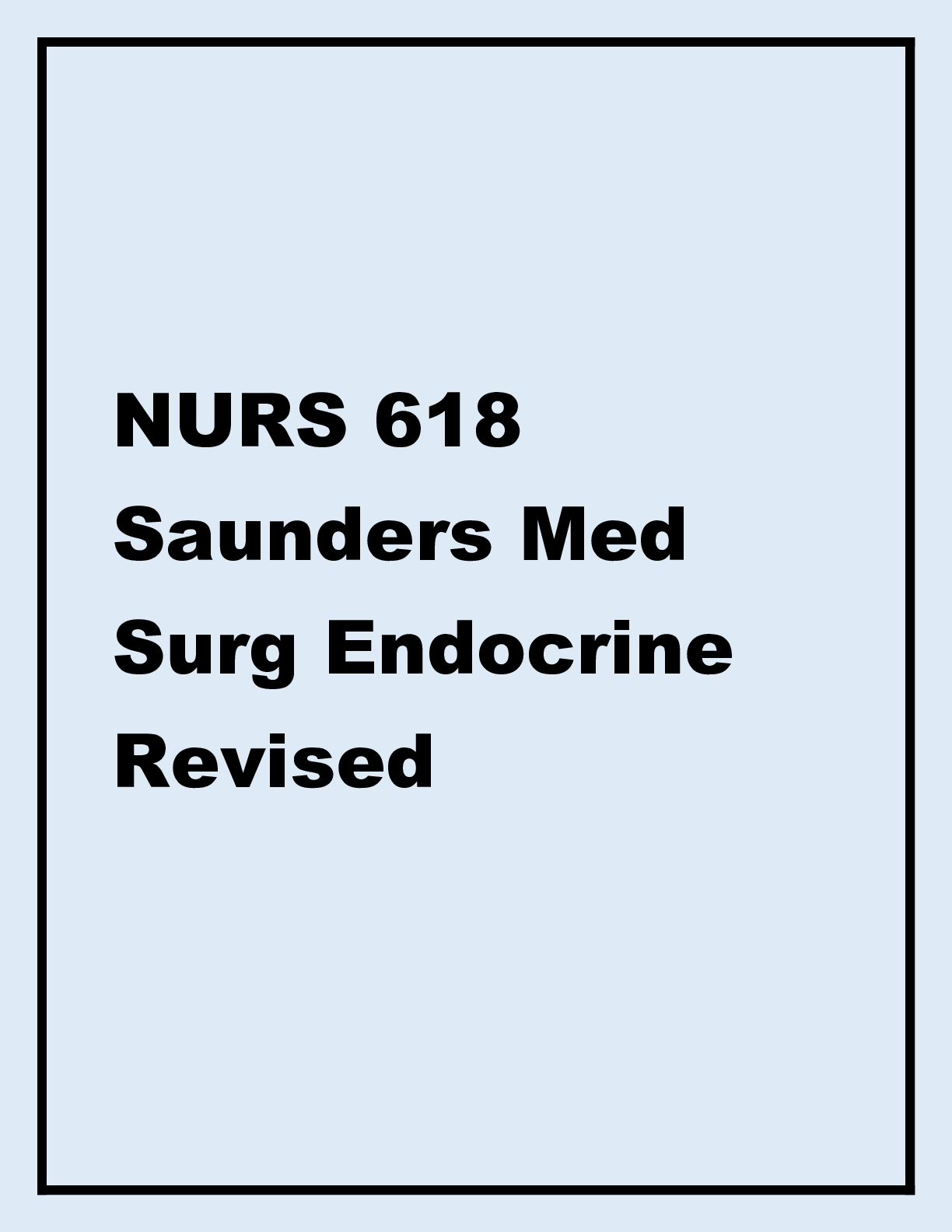*NURSING > MED-SURG EXAM > NURS 618 Saunders Med Surg Immune Revised 2020 | NURS618 Saunders Med Surg Immune (All)
NURS 618 Saunders Med Surg Immune Revised 2020 | NURS618 Saunders Med Surg Immune
Document Content and Description Below
NURS 618 Saunders Med Surg Immune Revised 2020 Saunders Med Surg Immune 1. The nurse provides home care instructions to a client with systemic lupus erythematosus and tells the client about meth... ods to manage fatigue. Which statement by the client indicates a need for further instruction? 1. "I should take hot baths because they are relaxing." 2. "I should sit whenever possible to conserve my energy." 3. "I should avoid long periods of rest because it causes joint stiffness." 4. "I should do some exercises, such as walking, when I am not fatigued." Answer: • "I should take hot baths because they are relaxing." Rationale: To help reduce fatigue in the client with systemic lupus erythematosus, the nurse should instruct the client to sit whenever possible, avoid hot baths (because they exacerbate fatigue), schedule moderate low-impact exercises when not fatigued, and maintain a balanced diet. The client is instructed to avoid long periods of rest because it promotes joint stiffness. 3. The nurse is assisting in planning care for a client with a diagnosis of immunodeficiency and should incorporate which action as a priority in the plan? 1. Protecting the client from infection 2. Providing emotional support to decrease fear 3. Encouraging discussion about lifestyle changes 4. Identifying factors that decreased the immune function Answer: • Protecting the client from infection Rationale: The client with immunodeficiency has inadequate or absence of immune bodies and is at risk for infection. The priority nursing intervention would be to protect the client from infection. Options 2, 3, and 4 may be components of care but are not the priority. 4. A client calls the nurse in the emergency department and states that he was just stung by a bumblebee while gardening. The client is afraid of a severe reaction because the client's neighbor experienced such a reaction just 1 week ago. Which action should the nurse take? 1. Advise the client to soak the site in hydrogen peroxide. 2. Ask the client if he ever sustained a bee sting in the past. 3. Tell the client to call an ambulance for transport to the emergency department. 4. Tell the client not to worry about the sting unless difficulty with breathing occurs. Answer: • Ask the client if he ever sustained a bee sting in the past. Rationale: In some types of allergies, a reaction occurs only on second and subsequent contacts with the allergen. The appropriate action, therefore, would be to ask the client if he ever experienced a bee sting in the past. Option 1 is not appropriate advice. Option 3 is unnecessary. The client should not be told "not to worry." 6. Which interventions apply in the care of a client at high risk for an allergic response to a latex allergy? Select all that apply. 1. Use nonlatex gloves. 2. Use medications from glass ampules. 3. Place the client in a private room only. 4. Keep a latex-safe supply cart available in the client's area. 5. Avoid the use of medication vials that have rubber stoppers. 6. Use a blood pressure cuff from an electronic device only to measure the blood pressure. Answers: 1. Use non-latex gloves. 2. Use medications from glass ampules. 4. Keep a latex-safe supply cart available in the client's area. 5. Avoid the use of medication vials that have rubber stoppers. Rationale: If a client is allergic to latex and is at high risk for an allergic response, the nurse would use nonlatex gloves and latex-safe supplies, and would keep a latex-safe supply cart available in the client's area. Any supplies or materials that contain latex would be avoided. These include blood pressure cuffs and medication vials with rubber stoppers that require puncture with a needle. It is not necessary to place the client in a private room. - - - - - - - - - - - - - - - - - - - - - - - - - - 13. The home care nurse is preparing to visit a client who has undergone renal transplantation. The nurse develops a plan of care that includes monitoring the client for signs of acute graft rejection. The nurse documents in the plan to assess the client for which signs of acute graft rejection? 1. Fever, hypotension, and polyuria 2. Hypertension, polyuria, and thirst 3. Fever, hypertension, and graft tenderness 4. Hypotension, graft tenderness, and hypothermia Answer: 3. Fever, hypertension, and graft tenderness Rationale: Rejection is the most serious complication of transplantation and the leading cause of graft loss. In rejection, a reaction occurs between the tissues of the transplanted kidney and the antibiodies and cytotoxic T-cells in the recipient's blood. These substances treat the new kidney as a foreign invader and cause tissue destruction, thrombosis, and eventual kidney necrosis. Acute rejection usually occurs within 3 months after transplantation, although it can occur up to 2 years after transplantation. The client exhibits fever, hypertension, malaise, and graft tenderness. Treatment with corticosteroids, and possibly also with monoclonal antibodies and antilymphocyte agents, is begun immediately. 14. A client with acquired immunodeficiency syndrome (AIDS) has been started on therapy with zidovudine. The nurse should monitor the results of which laboratory blood study for adverse effects of therapy? 1. Creatinine level 2. Potassium concentration 3. Complete blood cell (CBC) count 4. Blood urea nitrogen (BUN) level Answer: 3. Complete blood cell (CBC) count Rationale: Acquired immunodeficiency syndrome is a viral disease caused by the human immunodeficiency virus (HIV), which destroys T cells, thereby increasing susceptibility to infection and malignancy. Common adverse effects of zidovudine are agranulocytopenia and anemia. The nurse should monitor the CBC count for these changes. Creatinine, potassium, and BUN are unrelated to this medication. 18. A client who has been receiving pentamidine intravenously now has a fever with a temperature of 102°F (38.9°C). Keeping in mind that the client has a diagnosis of acquired immunodeficiency syndrome (AIDS) and Pneumocystis jiroveci pneumonia, the nurse should interpret that this fever is most associated with which condition? 1. Inadequate thermoregulation 2. Insufficient medication dosing 3. Toxic nervous system effects from the medication 4. Infection caused by leukopenic effects of the medication Answer: 4. Infection caused by leukopenic effects of the medication Rationale: Acquired immunodeficiency syndrome is a viral disease caused by the human immunodeficiency virus (HIV), which destroys T cells, thereby increasing susceptibility to infection and malignancy. Pneumocystis jiroveci pneumonia (PCP) is a fungal infection and is a common opportunistic infection. Adverse effects of pentamidine include leukopenia, thrombocytopenia, and anemia. The client should be routinely assessed for signs and symptoms of infection. The remaining options are inaccurate interpretations. 19. A client is diagnosed with stage I Lyme disease, and the nurse assesses the client for disease manifestations. Which should the nurse expect to note as the hallmark characteristic of this stage? 1. Skin rash 2. Arthralgias 3. Neurological deficits 4. Enlarged and inflamed joints Answer: 1. Skin rash Rationale: Lyme disease is a reportable systemic infectious disease caused by the spirochete Borellia burgdorferi and results from the bite of an infected deer tick, also known as the black-legged tick. The hallmark finding in stage I is a skin rash that appears within 2 to 30 days of infection, generally at the site of the tick bite. The rash develops into a concentric ring, giving it a bull's eye appearance (however, not all clients develop this characteristic). The lesion enlarges to up to 50 to 60 cm, and smaller lesions develop farther away from the original tick bite. Not all persons exhibit a skin rash but in addition, in stage I, most infected persons experience flulike symptoms that last 7 to 10 days and may recur later in the disease course. Arthralgias, neurological deficits, and enlarged and inflamed joints develop in later stages of the disease. 20. Assessment and diagnostic evaluation reveal that a client seen in the ambulatory care clinic has stage II Lyme disease. The clinic nurse identifies which assessment finding as most characteristic of this stage? 1. Arthralgias 2. Joint enlargement 3. Erythematous rash 4. Cardiac conduction deficits Answer: 4. Cardiac conduction deficits Rationale: Lyme disease is a reportable systemic infectious disease caused by the spirochete Borellia burgdorferi and results from the bite of an infected deer tick, also known as the black-legged tick. Stage II of Lyme disease develops within 1 to 6 months in a majority of untreated persons. The most serious problems include cardiac conduction deficits and neurological disorders such as Bell's palsy and paralysis. Arthralgias and joint enlargement are noted in stage III. A rash appears in stage I. 21. The clinic nurse reads the chart of a client just seen by the health care provider (HCP) and notes that the HCP has documented that the client has stage III Lyme disease. Which clinical manifestation should the nurse expect to note in this client? 1. Generalized skin rash 2. Cardiac dysrhythmia 3. Complaints of joint pain 4. Paralysis of the affected extremity Answer: 3. Complaints of joint pain Rationale: Lyme disease is a reportable systemic infectious disease caused by the spirochete Borellia burgdorferi and results from the bite of an infected deer tick, also known as the black-legged tick. Stage III develops within a month to several months after initial infection. It is characterized by arthritic symptoms, such as arthralgias and enlargement or inflammation of joints, which can persist for several years after the initial infection. Cardiac and neurological dysfunction occurs in stage II. A rash occurs in stage I. Paralysis of the extremity on which the bite occurred is not a characteristic of Lyme disease. 22. A client arrives at the health care clinic and tells the nurse that he was just bitten by a tick and would like to be tested for Lyme disease. The client reports that he removed the tick and flushed it down the toilet. The nurse should take which nursing action? 1. Refer the client for a blood test immediately. 2. Ask the client about the size and color of the tick. 3. Tell the client to return to the clinic in 4 to 6 weeks. 4. Inform the client that the tick is needed to perform a test. - - - - - - - - - - - - - - - - - - - - - - - - - Latex allergy is a type I hypersensitivity reaction in which a specific allergen is a processed natural latex rubber protein. Cotton pads and plastic or silk tape are latex-free products. The items identified in the other options contain latex. 84. A client with a history of asthma comes to the emergency department complaining of itchy skin and shortness of breath after starting a new antibiotic. What is the first action the nurse should take? 1. Place the client on 100% oxygen and prepare for intubation. 2. Assess for anaphylaxis and prepare for emergency treatment. 3. Teach the client about the relationship between asthma and allergies. 4. Obtain an arterial blood gas and immunoglobulin E (IgE) blood level. Answer: 2. Assess for anaphylaxis and prepare for emergency treatment. Rationale: Hypersensitivity or allergy is excessive inflammation occurring in response to the presence of an antigen to which the person usually has been previously exposed. If a client is experiencing an allergic or hypersensitivity response, the nurse's initial action is to assess for anaphylaxis. Promptly notifying the health care provider and preparing emergency equipment, including medication such as epinephrine and possible corticosteroids, is essential in preventing progression of anaphylaxis. Laboratory work is not a priority in this situation. The nurse would expect the IgE level to be elevated; the client may be hypoxic. The nurse would give the client supplemental oxygen; however, 100% is not given unless prescribed, and based on the information in the question intubation is not the first thing the nurse would prepare this client for. Teaching the client is important; however, this is not the right time. When the client is stabilized, the nurse should teach or reinforce that allergies, including some medications, are common triggers for asthma attacks and that people with asthma are predisposed to more allergies than people without asthma. 85. The nurse is preparing to care for a client with immunodeficiency. The nurse should plan to address which problem as the priority? 1. Anxiety 2. Fatigue 3. Risk for infection 4. Need for social isolation Answer: 3. Risk for infection Rationale: The client with immunodeficiency has inadequate or no immune bodies and is at risk for infection. The priority concern would be risk for infection. The question presents no data indicating that the client is experiencing anxiety. Fatigue may be a problem and the client may need to be placed on protective isolation, but these are not the priority problems for this client. Infection can be life-threatening and is the priority. 86. The nurse caring for a client who has undergone kidney transplantation is monitoring the client for organ rejection. Which findings are consistent with acute rejection of the transplanted kidney? Select all that apply. 1. Oliguria 2. Hypotension 3. Fluid retention 4. Temperature of 99.6°F (37.6°C) 5. Serum creatinine of 3.2 mg/dL (282 mcmol/L) Answers: 1. Oliguria 3. Fluid retention 5. Serum creatinine of 3.2 mg/dL (282 mcmol/L) Rationale: Rejection is the most serious complication of transplantation and the leading cause of graft loss. In rejection, a reaction occurs between the tissues of the transplanted kidney and the antibiodies and cytotoxic T-cells in the recipient's blood. These substances treat the new kidney as a foreign invader and cause tissue destruction, thrombosis, and eventual kidney necrosis. Acute rejection is the most common type that occurs with kidney transplants and occurs 1 week to any time postoperatively. It occurs over days to weeks. Findings consistent with acute rejection include oliguria or anuria; temperature higher than 100°F (37.8°C); increased blood pressure; enlarged, tender kidney; lethargy; elevated serum creatinine, blood urea nitrogen, and potassium levels; and fluid retention. 87. A client is admitted to the hospital with a diagnosis of parasitic worms. After reviewing the client's complete blood cell (CBC) count, the nurse should expect an increased laboratory value for which cells? 1. Basophils 2. Neutrophils 3. Eosinophils 4. Dendritic cells Answer: 3. Eosinophils Rationale: Eosinophils attack and destroy foreign particles that have been coated with antibodies of the immunoglobulin E (IgE) class. Their usual target is helminths (parasitic worms). Basophils mediate immediate hypersensitivity reactions. Dendritic cells perform the same antigen-presenting task as macrophages. Neutrophils phagocytize foreign particles such as bacteria. 88. The nurse works with high-risk clients in an urban outpatient setting. Which groups should be tested for human immunodeficiency virus (HIV)? Select all that apply. 1. Injection drug abusers 2. Prostitutes and their clients 3. People with sexually transmitted infections (STIs) 4. People who have had frequent episodes of pneumonia 5. People who recently received a blood transfusion for a surgical procedure Answers: 1. Injection drug abusers 2. Prostitutes and their clients 3. People with sexually transmitted infections (STIs) Rationale: Human immunodeficiency virus (HIV) can cause acquired immunodeficiency syndrome, which is a viral disease that destroys T cells, thereby increasing susceptibility to infection and malignancy. Injection drug abusers, those engaged in prostitution, and people with STIs are high-risk groups that should be tested for HIV per the Centers for Disease Control and Prevention's recommendations. Those who have had frequent episodes of pneumonia and those who recently received a blood transfusion for a surgical procedure are not at risk for HIV unless another compounding factor places them at risk. However, if a blood transfusion was received between 1978 and 1985, the client should be tested. 90. The nurse provides education to the client about the primary purpose of neutrophils. Which statement by the client indicates successful teaching? 1. "They open up blood vessels." 2. "They close up blood vessels." 3. "They increase fluids at the injury site." 4. "They engulf any potential foreign materials." Answer: 4. "They engulf any potential foreign materials." Rationale: Neutrophil function provides protection after invaders, especially bacteria, enter the body. In the inflammatory response, neutrophils appear in the area of injury in 30 to 60 minutes. Their primary purpose is to phagocytize (ingest and destroy) any potentially harmful agents, such as microorganisms. The remaining options are incorrect. 91. The nurse provides education to the student about the process of phagocytosis. Which statement by the student indicates successful teaching? 1. "It is the first stage of inflammation." 2. "It is a process of blood cell production." 3. "It is a process of blood cell destruction." 4. "It is a process of ingesting and destroying any potentially foreign materials, such as germs." Answer: 4. "It is a process of ingesting and destroying any potentially foreign materials, such as germs." Rationale: Phagocytosis, an important nonspecific immune response, is a process in which the particle is ingested and digested by a cell. This rids the body of debris after tissue injury. The other options are incorrect. [Show More]
Last updated: 1 year ago
Preview 1 out of 61 pages
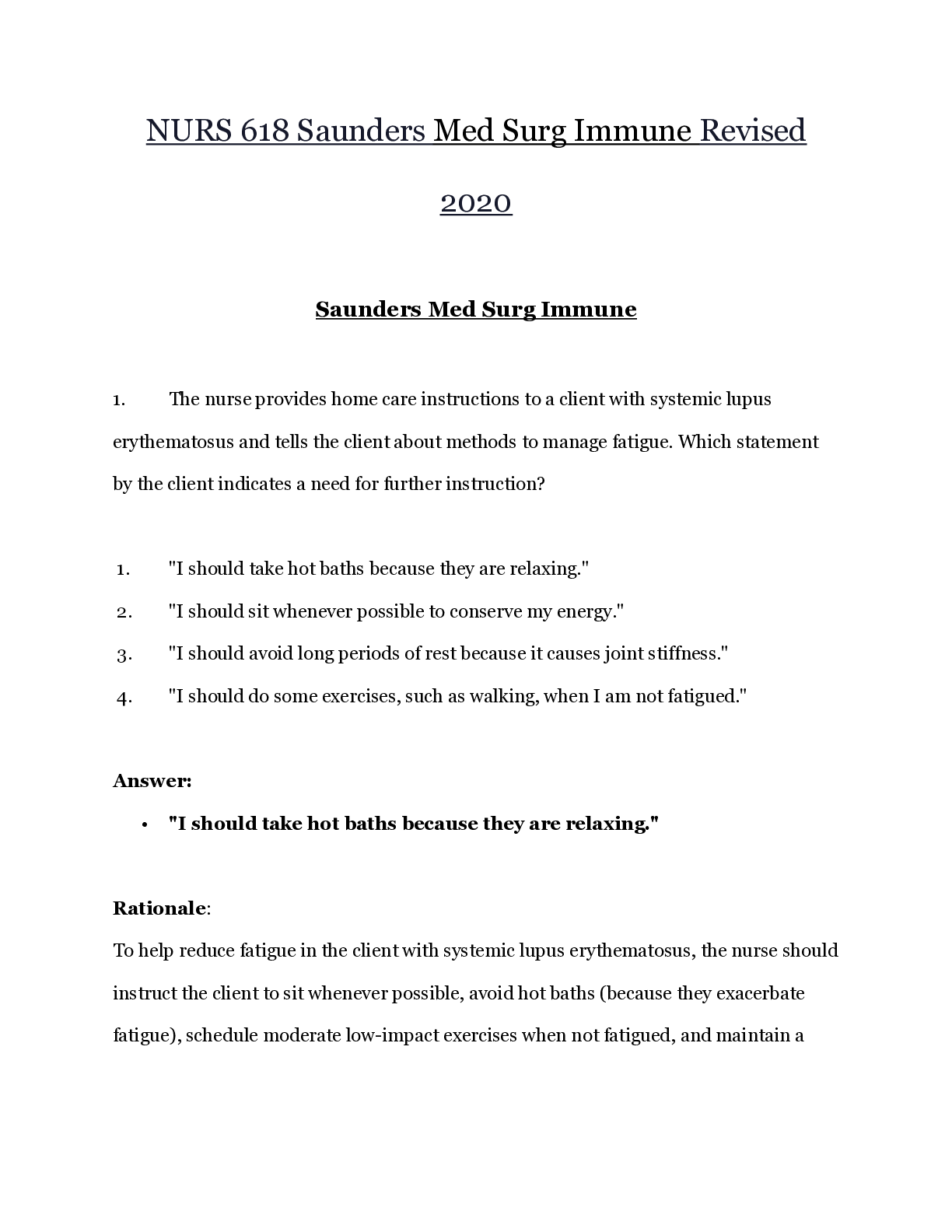
Reviews( 0 )
Document information
Connected school, study & course
About the document
Uploaded On
Nov 04, 2020
Number of pages
61
Written in
Additional information
This document has been written for:
Uploaded
Nov 04, 2020
Downloads
1
Views
74
